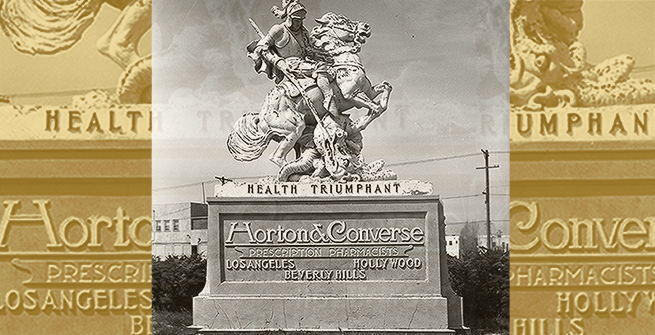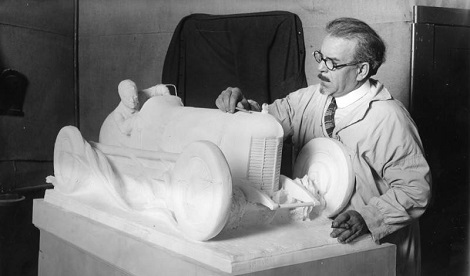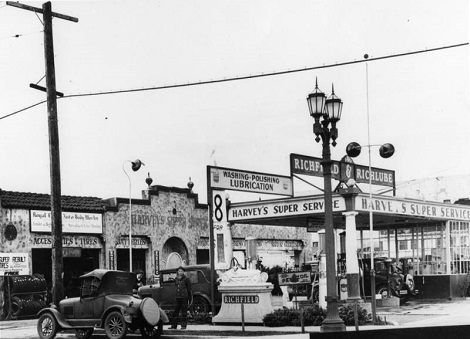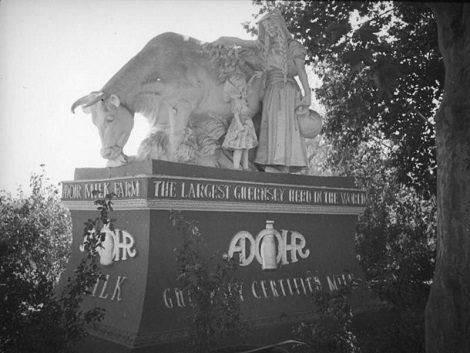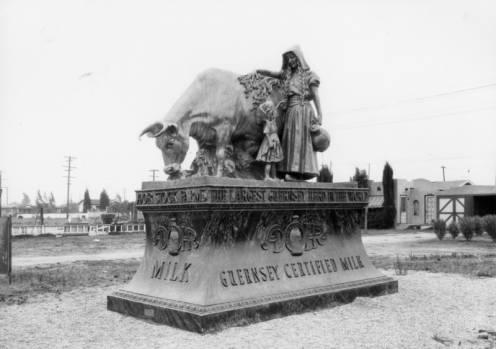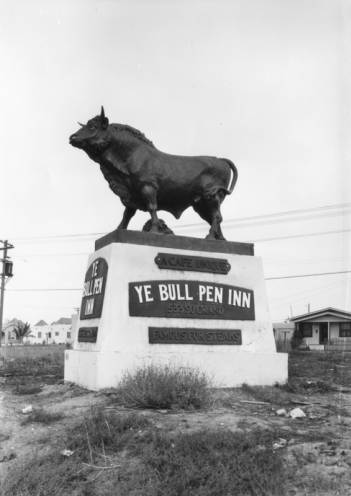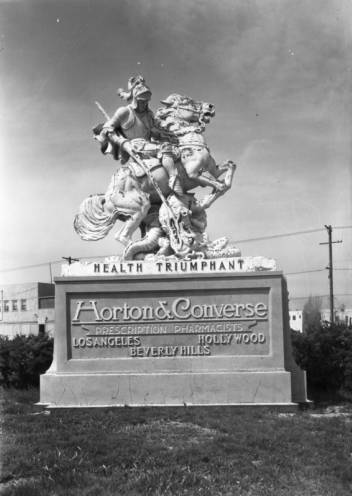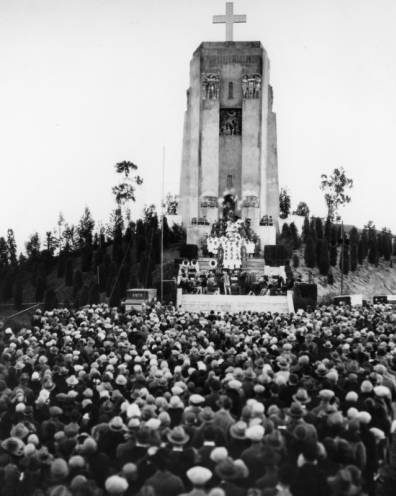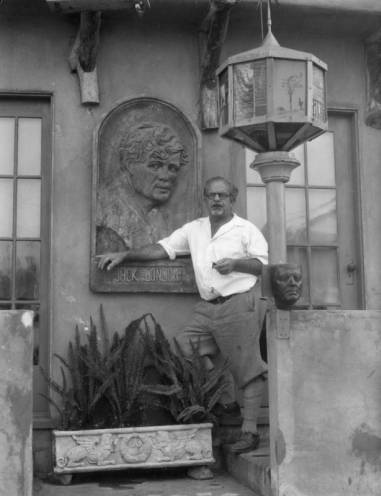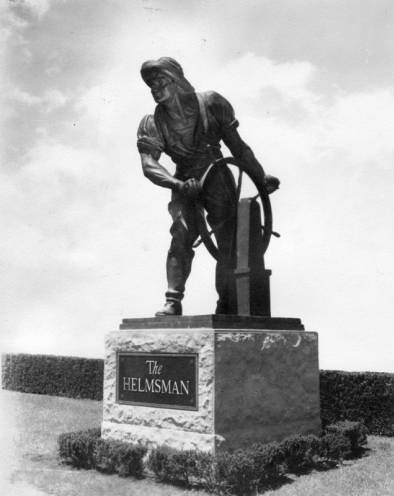Stand aside muffler men! Fresh milk from a Guernsey cow, high octane fuel fit for an Indy 500 winner, and steak dinners from a stockade-themed eatery are just a few of the products that early-twentieth-century sculptors helped sell to Angelenos. I first encountered these intriguing advertising statues in Tessa, the digitized historical collections of the Los Angeles Public Library. I ordered a few books from Library to Go but only found brief mentions. Who created the statues? What happened to them? It was the library's photo collection that sparked the hunt for information, but additional online library resources were needed to learn more of their story. The Los Angeles Times Historical Archives (via Proquest), Access Newspaper Archives, digitized city directories, online Sanborn maps, Ancestry.com, and the California Index helped me piece together a bit of the history of these advertising enigmas. The information I’ve uncovered so far spans two companies and at least three sculptors with ties to the movie industry. There is even a curious connection to the Central Library and an opportunity to visit the remaining statues.
Findings suggest the local sculptural advertising “craze” began in 1926 alongside the rise of programmatic architecture. Thanks to increased boosterism, the growth of the automobile age, and the booming movie industry, Los Angeles of the mid-1920s was ripe for this new twist on outdoor advertising that combined art and advertising. These advertising statues not only fit the bill, but they were also relatively cheap to make. Most were made of plaster, cast from molds, and “properly lacquered” or “metalized” which made them look bronzed or marbled, as well as protected them from the elements.
By 1927, two companies used sculpture for advertisements. The Art-vertising Corporation of America (formerly known as Hollywood Workshop) and Hy-Art Hy-Way Display Corporation (also known as Hy-Art Studio) were the catchily named entities behind the advertising statues. Thanks to digitized city directories we can learn company locations, former business names and approximate years of operation (1926-1931). Based on published sources, the first of the advertising statues was produced by the Art-vertising Corporation and spoke to the growth of the automobile age. The Los Angeles Times frequently mentioned that winners of auto races used “California-made” gas from the Richfield Oil Company. In 1926, to celebrate this claim, Richfield commissioned sculptor Finn Haakon Frolich (1858-1947) and Art-vertising to create sculptural advertisements that could be used along the roadside to advertise Richfield gas stations. Smaller versions of the statue were displayed at some of the stations themselves. Frolich, who was a well-known and highly visible sculptor in Los Angeles at the time, sculpted “Modern Speed” for Richfield’s purposes. Richfield promotional maps of the period also featured the image of the statue.
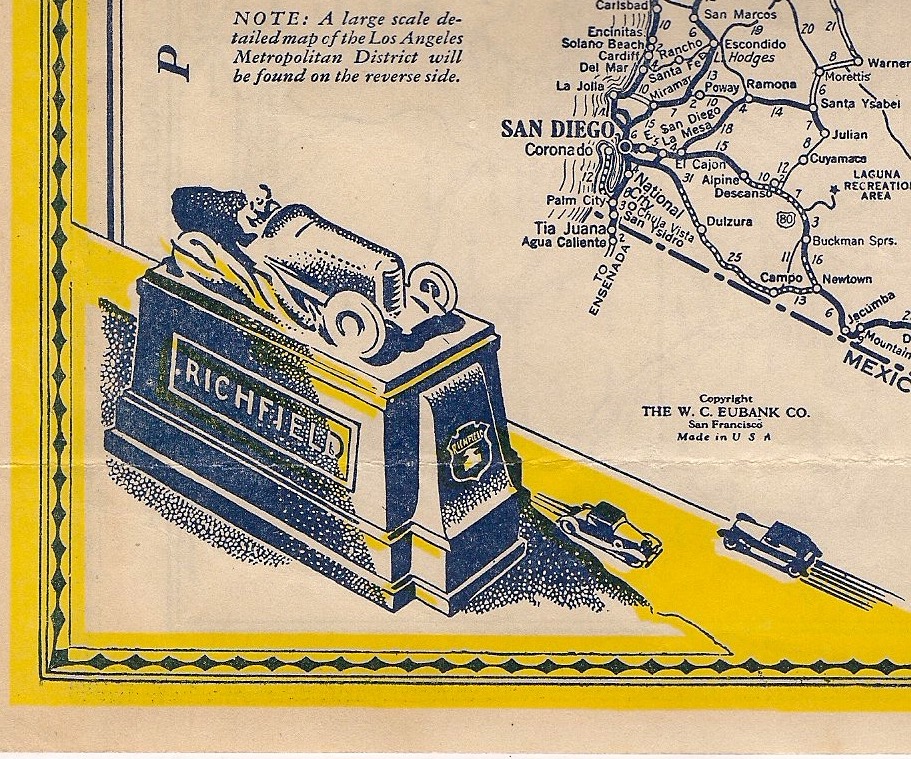
Newspapers from the end of 1926 showed that Frolich worked on another recognizable statue. This time he was commissioned by Merritt H. Adamson, President of Adohr Farms, to sculpt a statue of a dairymaid and her Guernsey cow. Just as with the Richfield statues, these milkmaid statues were displayed around the city at select Adohr Farms locations. Newspaper articles place two of the statues at the Adohr Stock Farm on Ventura Blvd near Lindley (one statue each at the north and south entrances) as well as at the Adohr main plant on La Cienega. The milkmaid statue was additionally featured in Adohr newspaper ads and promotional materials. Remarkably one statue still exists outside of a former Adohr Farms location in Tulare, California.
Newspapers were the best resource for deciphering the sculptors and learning what they were working on. Finn Haakon Frolich was the sculptor most associated with the Art-vertising Corporation of America and Carlo Alfred Romanelli (1872-1947) was the lead sculptor for Hy-Art Studios. Both men worked for the movie studios during the 1920s. Frolich served as the head of Metro Pictures’ Technical Department beginning in 1921. He created sculptures for several Rex Ingram films and the 1923 version of The Hunchback of Notre Dame. Frolich also created the statues for the 1935 film Night Life of the Gods, which was based on a Thorne Smith book. The film is about a ring that gives the wearer the power to turn people to stone. Not only are there statues throughout the film, but several also come to life. Frolich may have appeared in films as well. Newspaper publicity for the 1923 film Trilby, the story of Svengali, reported that director James Young sought a location with a Bohemian atmosphere. As a result, Young filmed Frolich, and his fellow artists at the Norse Studio Club at 6426 Sunset. Norse Studio Club was Frolich’s creation, a locale for art shows, events, and weekly parties that combined a mix of artists, sculptors, actors, singers, and other “artistic types'' who contributed their talents. Meanwhile, in 1915, Carlo A. Romanelli was the sculptor of the elephant and lion sculptures adorning the Selig Zoo entrance gates. Romanelli later created sculptures for The Hands of Nara (1922) and King Vidor’s 1923 The Woman in Bronze, both starring Clara Kimball Young. Both of these films were from Metro Pictures where Frolich headed the Technical Department.
Both sculptors expressed their belief that advertising should be more beautiful and artistic. In a 1927 article, the Los Angeles Times revealed that Romanelli’s Hy-Art Studio at 1041 N. Sycamore was becoming more factory-like “for the purpose of turning out the quantities of sculptured signs which are his specialty.” Romanelli explained to the reporter that advertising was ubiquitous but there was no reason it should not also be artistic. Similarly, across several illustrated articles, Frolich spoke of teaching others about sculpting and the importance of art education. By the mid-1920s he had opened the Frolich School of Sculpture and Other Arts (the brochure credits Frolich as the originator of “outdoor sculptured advertising”) and was teaching the plastic arts at Fairfax High School as well. Frolich pointed out that the advertising industry was already becoming more artistic by hiring artists to create print and billboard advertisements. He felt that sculptural advertising followed suit by hiring sculptors such as himself to create them. According to the brochure for his sculpting school, Frolich’s purpose was to “assist his students in establishing home studios; to revive here in beautiful Southern California the creative spirit of seventeenth-century Europe,” taking pride in making “a superior piece of work” with one’s own hands.
Whereas Art-vertising advertising statues were promoted by Frolich in press coverage and photographs, visual examples of Hy-Art Studio statues have been more elusive. Newspaper accounts of statues created by Carlo Romanelli in 1927 include at least one advertising statue featuring Janet Gaynor in her role for the film 7th Heaven, which was placed at the Carthay Circle Theatre for an indeterminate time. Romanelli and Hy-Art Studio also completed commemorative statues in 1927. Multiple statues of Charles Lindbergh were created to celebrate his solo transatlantic flight. According to the Los Angeles Times, one Romanelli statue was unveiled north of Clover Field in Lindbergh Park in July 1927, accompanied by thousands of miniature versions given as souvenirs, and another was displayed outside of the Los Angeles Times Building on Charles A. Lindbergh Day, September 20, 1927.
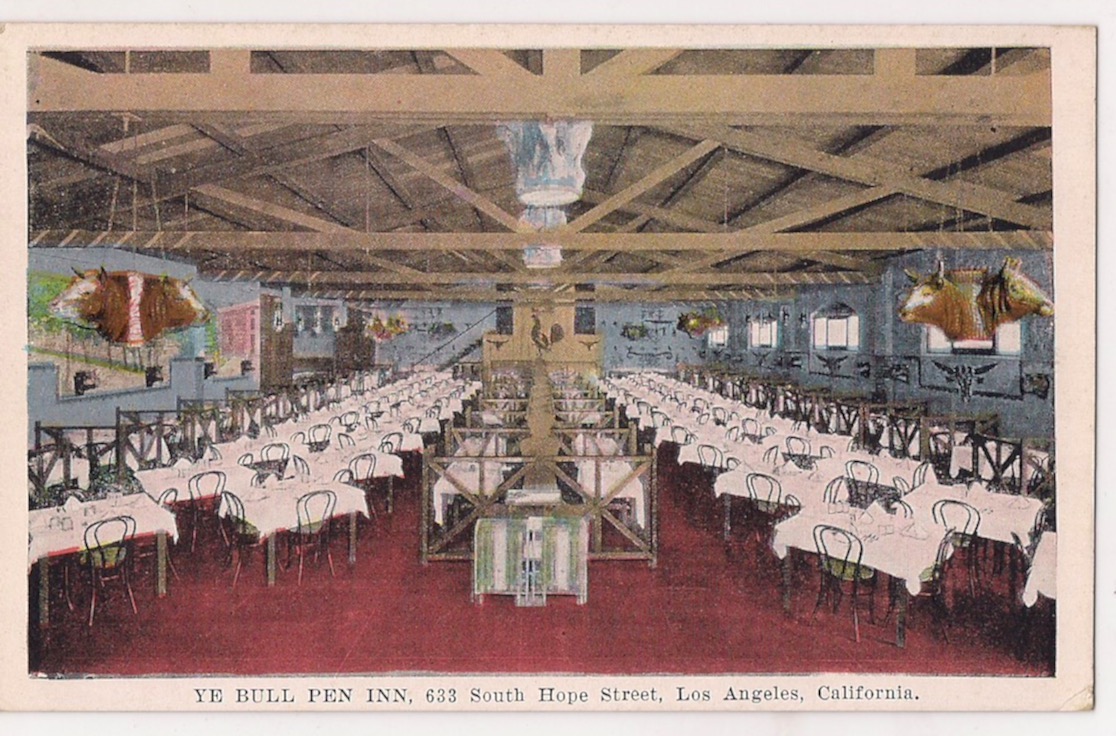
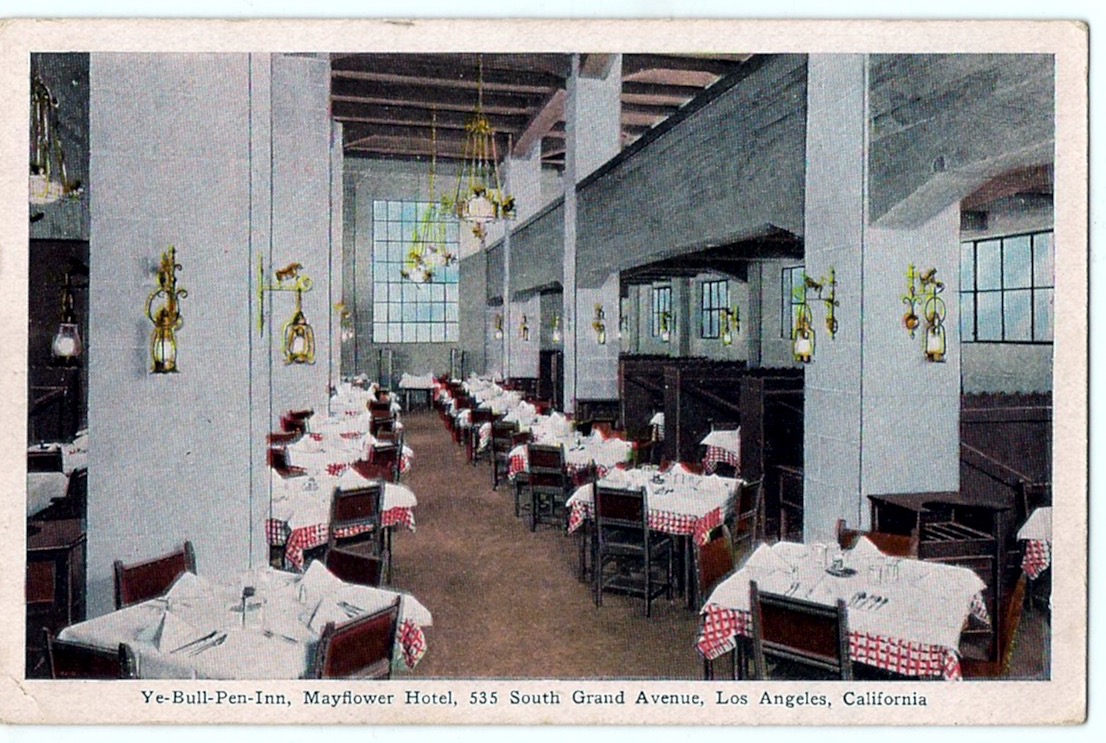
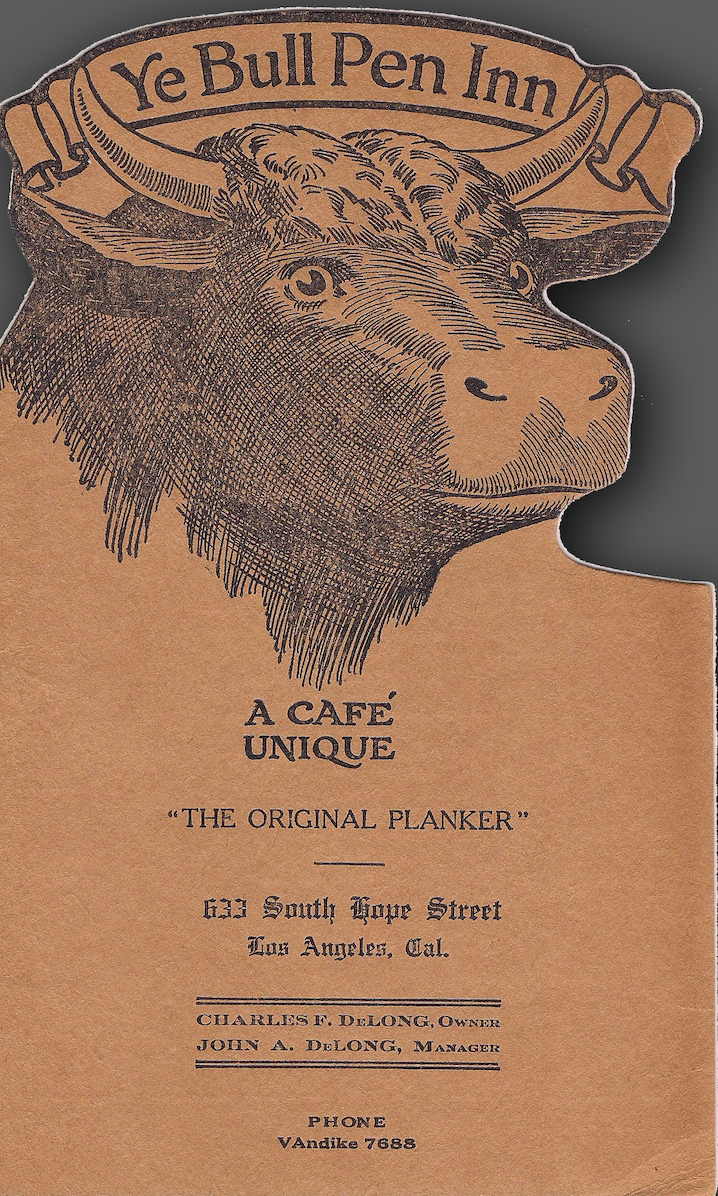
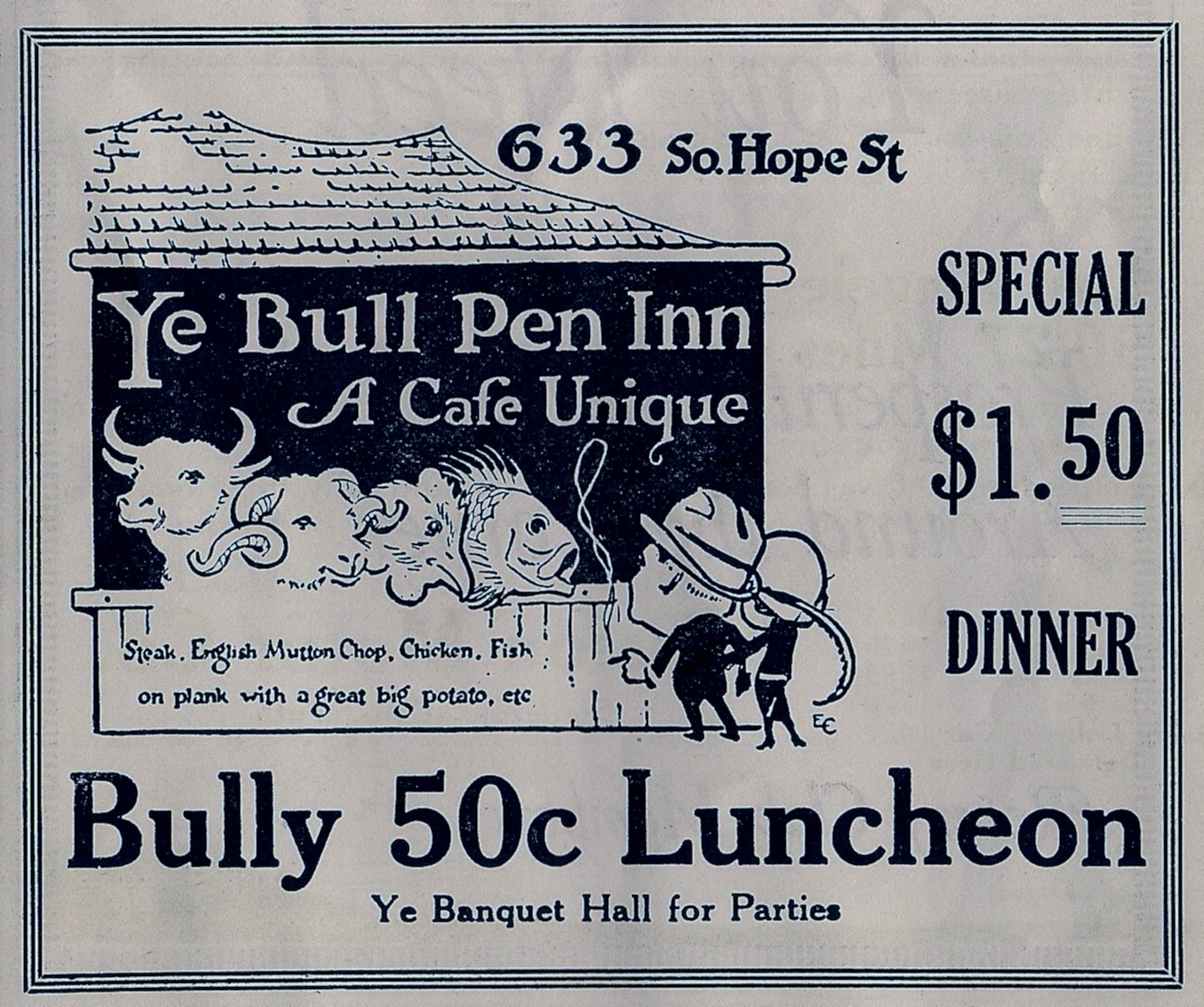
A few newspapers featured photos of Frolich sculpting the Richfield Oil and Adohr Farms statues. Based on design similarities it is possible that additional statues found in Tessa are associated with the Art-vertising Corporation of America. A statue of a bull advertises Ye Bull Pen Inn, a steakhouse that featured a stockade theme with stalls for diners. Two locations, on Hope Street and Grand Avenue, around the corner from Central Library in the Mayflower Hotel, were advertised with statues. A statue of a bull advertising a steakhouse seems like a plausible representation while others require more context. The sculptural advertisement for the Horton & Converse chain of pharmacies is one such example. Charles S. Horton and Lawrence R. Converse, the pharmacists that started the company, chose the iconography of St. George slaying the dragon as the logo of their pharmacy. Their slogan, “Health Triumphant,” appears on the statue base. According to a company history, the logo and slogan implied the pharmacy’s goal of eliminating disease. It should be noted that Horton & Converse is still in business although they now provide medical supplies instead of pharmaceuticals.
Frolich and his art appear several times in the library's photo collection. This makes sense, based on Los Angeles newspaper accounts of Frolich’s extensive artistic output, high-spirited Bohemian parties, as well as the art clubs he started or belonged to. For instance, before researching Frolich I’d never heard of the Tower of Legends in Forest Lawn Glendale. The 1925 structure, designed by architect Charles H. Kyson, featured architectural sculptures by Frolich. Photos in Tessa show the Tower of Legends as a popular Easter service destination. Sadly it was demolished in 1948 and was replaced by the Hall of the Crucifixion-Resurrection. There are also great photos of Frolich at his Hollywood home and studio at 5152 La Vista Court, near Paramount Studio. Frolich designed the home and included his bas-relief of close friend, Jack London, in a prominent location on the facade. Frolich’s bas-relief led many to believe that London lived there at some point but alas the home was built years after the author’s death in 1916. The bas-relief is still there today and the home retains many other original features, such as a block and tackle winch beam that was used to move materials and sculptures between Frolich’s studio and the ground. The home was made a Historic-Cultural Monument in 2017.
Not everyone saw outdoor advertising as art. During the 1920s, local officials and women’s clubs were fighting against the proliferation of billboard blight. Concerns that sculptural advertisements were every bit the eyesore that billboards were becoming in 1927. In the October issue of Architect & Engineer, Southland architect Robert H. Orr bemoaned that the advertising statues were dragging down the art of sculpture by making it commonplace. Hy-Art Studio made headlines in 1928 with a “sinful” statue of a couple dancing that advertised ginger ale. The statue in question was placed in Glendale on East Colorado Street. Robert Sterner, another Hy-Art Studio sculptor, made the “sin-statue” that depicted a dancing couple. The Women’s Christian Temperance Union was aghast by the statue while Sterner, who later worked for Disney, argued that it was a less suggestive pose than could be found on the dance floor of the Biltmore or Ambassador on any given night. In the 1920s and 30s, the Los Angeles Times was full of anti-billboard articles and requests for their removal from residential areas. Ultimately, legislation regulated outdoor advertising, bringing it under the control of the Board of Public Works and requiring advertisers to purchase a permit.
While much information on these advertising statues was found using library resources, so many questions remain and will require more digging. For example, I would like to know more about the Art-vertising Corporation of America, Hy-Art Studios, the Advertising Club of Los Angeles, and the types of permits required to advertise in the city. The latest mystery involves the Helmsman statue, which once stood on Venice Blvd. across from Helms Bakery. Is it the work of Carlo Romanelli during his Hy-Art Studio days or is it the work of his son Carl Romanelli? It has been attributed to each sculptor by different reliable sources. The Helmsman currently stands in Burton Chace Park in Marina Del Rey and is on the list to visit soon to see if there is a clue.
Learning about Finn Haakon Frolich has yielded a steady stream of pleasant surprises. Born in what is now Oslo, Norway in 1858, he led a colorful life—highlights include an École des Beaux-Arts education and participation in the early twentieth century bohemian life in Greenwich Village and Seattle. He was also Director of Sculpture for the Alaska-Yukon-Pacific Exposition, as well as a contributor to the world’s fairs in Chicago and St. Louis. Incredibly, Ancestry.com led to one surprising fact that hit close to home. Lee Lawrie, the sculptor whose remarkable work is featured throughout Central Library, was married to Frolich’s sister, Ingeborg, from 1897 until her death in 1937. Both Frolich and Lawrie worked in the New York studio of famed sculptor Augustus St. Gaudens but it will take further digging to know the extent that their professional lives intersected. There's also curiosity about whether their paths crossed while Lawrie was in Los Angeles working on his Central Library commission.
